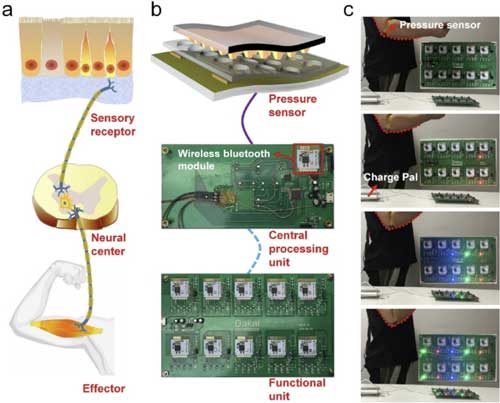| Apr 21, 2020 | |
Flexible pressure sensor for human-machine interaction(Nanowerk News) Flexible pressure sensors have attracted considerable attention due to their potential applications in electronic skins. To date, lots of approaches have been reported to achieve effective transformation from mechanical stimuli to electrical signals. |
|
| However, the underlying problem concerning distorted signal in real flexible-matrix-based scenes has not been well resolved yet. | |
| Researchers from the Shenzhen Institutes of Advanced Technology (SIAT) of the Chinese Academy of Sciences proposed a high-performance and zero-standby-power-consumption flexible pressure sensor with ultrahigh sensitivity in wide linear response range. | |
| The study was published in Nano Energy ("High-performance zero-standby-power-consumption-under-bending pressure sensors for artificial reflex arc"). | |
 |
|
| Illustration of the concept and application for the artificial somatic reflex arc. (Image: SIAT) (click on image to enlarge) | |
| Within the sensor structure, researchers introduced a tunable photoresist spacer (PS) sandwiched between the top truncated-pyramid microstructure polydimethylsiloxane (PDMS)/ aluminum-doped zinc oxide (AZO) and the bottom polyimide (PI)/gold (Au) interdigital electrode (PDMS-AZO/ PS/PI-Au). | |
| The newly proposed pressure sensor featured zero-standby-power-consumption when the bending angle was less than 20.5°, meanwhile it enabled effective transition from the insulation state to conduction state when the bending angle was above 20.5°. | |
| It also exhibited ultrahigh sensitivity of 2200 kPa-1 in the ultrawide linear response range of 62 Pa-9.6 kPa and fast response and recovery time (<20 ms). | |
| The team further designed an artificial somatic reflex arc to mimic the response in biological system. The sensor was attached on the elbow of the volunteer. As the volunteer increased the bending angle, the signal was transmitted through wireless Bluetooth module to the functional unit, and the LED-lit quantities in functional unit increased as well. | |
| These results demonstrated great potential of the newly proposed sensor in intelligent wearable devices. | |
| This newly sandwiched structure played a key role in achieving bending-insensitive merit, as well as zero-standby-power-consumption, which enhanced our understanding of bending-insensitive pressure sensor. |
| Source:Chinese Academy of Sciences | |
|
Subscribe to a free copy of one of our daily Nanowerk Newsletter Email Digests with a compilation of all of the day's news. |
